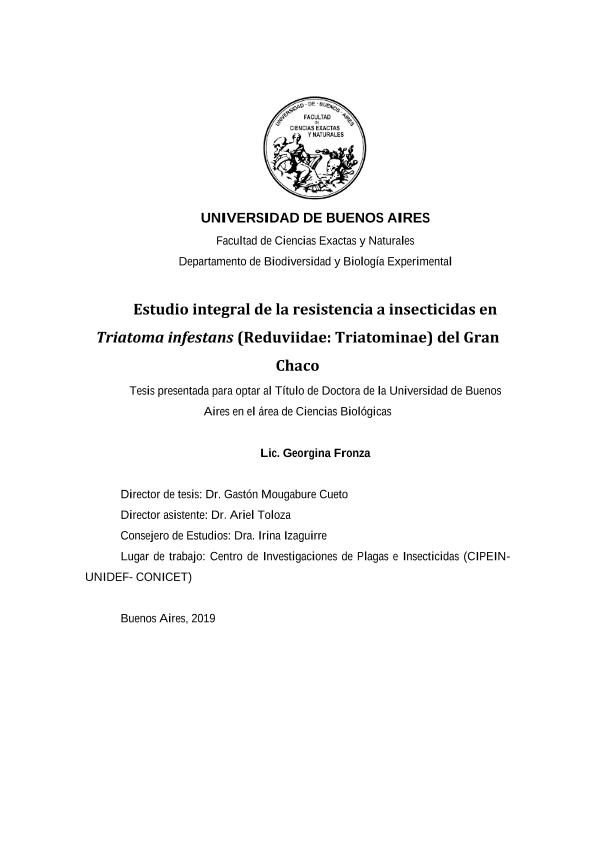Mostrar el registro sencillo del ítem
dc.contributor
Mougabure Cueto, Gastón Adolfo

dc.contributor
Toloza, Ariel Ceferino

dc.contributor.author
Fronza, Georgina

dc.date.available
2019-08-26T18:49:35Z
dc.date.issued
2019-03-26
dc.identifier.citation
Fronza, Georgina; Mougabure Cueto, Gastón Adolfo; Toloza, Ariel Ceferino; Estudio integral de la resistencia a insecticidas en Triatoma infestans (Reduviidae: Triatominae) del Gran Chaco; 26-3-2019
dc.identifier.uri
http://hdl.handle.net/11336/82126
dc.description.abstract
La enfermedad de Chagas afecta a más de un millón y medio de personas en Argentina y es transmitida principalmente por la vinchuca Triatoma infestans (Klug, 1834). El control químico del vector con insecticidas piretroides constituye la herramienta más utilizada para reducir la incidencia de la enfermedad. En los últimos años se han detectado fallas de control a campo en zonas del Gran Chaco Argentino, corroborándose en el laboratorio la ocurrencia de resistencia. El objetivo de esta tesis fue avanzar en el conocimiento de la evolución de la resistencia a insecticidas en poblaciones de campo de T. infestans mediante el uso combinado de herramientas de la toxicología, la genética y la ecología. Se analizó la distribución de la susceptibilidad en 69 poblaciones recolectadas en relevamientos entomológicos realizados por el Programa Nacional de Chagas y criadas en el laboratorio. Como resultado del análisis toxicológico, el 83 % de las poblaciones resultaron susceptibles a deltametrina, todas ellas pertenecientes a las provincias de Mendoza, San Juan, Tucumán, Santiago del Estero, Formosa, Catamarca y Chaco. Sólo se hallaron poblaciones resistentes en el Departamento chaqueño de Gral. Güemes. En este lugar, se caracterizó un patrón toxicológico complejo, compuesto por un 23 % de poblaciones susceptibles, un 41 % de poblaciones con baja resistencia (sin fallas de control a campo) y un 36 % de poblaciones con alta resistencia, estas últimas con los grados de resistencia (GR) más elevados detectados hasta el momento. La totalidad de las poblaciones resistentes a deltametrina resultó susceptible a fenitrotión, remarcando la importancia de este insecticida como la única alternativa de control a campo. Los ensayos bioquímicos en las poblaciones del foco resistente evidenciaron el aumento en la actividad de las enzimas degradativas oxidasas P450 y esterasas como mecanismo contributivo de la resistencia observada. Sin embargo, frecuencias altas de la mutación puntual L925I en el sitio de acción de los piretroides (el canal de sodio dependiente de voltaje) estarían determinando los GR elevados. Finalmente, se logró explicar el 70 % de la variabilidad toxicológica del foco a partir de predictores de temperatura, precipitación y extensión del paraje. Las variables de rociado, usadas como indicadores de la presión de selección por parte del insecticida, no contribuyeron a explicar el patrón toxicológico. Se propone que el ambiente podría estar modulando la presión de selección del insecticida, promoviendo la variabilidad toxicológica en una zona de gran complejidad en cuanto al control de T. infestans. Este conocimiento busca contribuir a generar estrategias integrales de control vectorial que permitan reducir la incidencia de la enfermedad.
dc.description.abstract
In Argentina, Chagas disease affects more than one and a half million people and is mainly transmitted by the kissing bug Triatoma infestans (Klug, 1834). Chemical control of the vector with pyrethroid insecticides has been the most frequently used tool to reduce the disease incidence. Recently, failures of field control have been detected in areas of the Argentinian Gran Chaco, and then the emergence of resistance has being corroborated in the laboratory. The main goal of this thesis was to advance in the knowledge of the evolution of the resistance to insecticides in field populations of T. infestans by the integration of several fields like toxicology, genetics and ecology. The distribution of susceptibility was analyzed in 69 populations collected in entomological surveys carried out by the National Chagas Program. From the toxicological analysis, 83% were susceptible to deltamethrin and were from the provinces of Mendoza, San Juan, Tucumán, Santiago del Estero, Formosa, Catamarca and Chaco. The only resistant populations were found in Gral. Güemes Department (Chaco province). In this area, a complex toxicological pattern was found that consisted of 23% of susceptible populations, 41% of populations with low resistance (without field control failures) and 36% of populations with high resistance. It is interesting to note that these latter possessed the highest degrees of resistance (RR) detected of the moment. All the populations resistant to deltamethrin were susceptible to fenitrothion, highlighting the importance of this insecticide as the only field control alternative. The biochemical tests in the populations of the resistant focus showed the increase in the activity of the degradative enzymes P450 oxidases and esterases as contributive mechanism of the resistance characterized. The genetics study revealed high frequencies of the L925I mutation at the site of action of the pyrethroids (the voltage-gated sodium channel) might be the responsible of the high RRs. Finally, the ecological analysis showed that 70% of the toxicological variability of the focus could be explained from temperature, precipitation and village extension predictors. Spray variables, used as indicators of the selection pressure by the insecticide, did not contribute to explain the toxicological pattern. It is proposed that the environment could be modulating the selection pressure of the 6 insecticide, promoting toxicological variability in an area of great complexity regarding the control of T. infestans. This thesis contribute to the generation of comprehensive vector control strategies that reduce the incidence of the disease.
dc.format
application/pdf
dc.language.iso
spa
dc.rights
info:eu-repo/semantics/openAccess
dc.rights.uri
https://creativecommons.org/licenses/by-nc-sa/2.5/ar/
dc.subject
Triatoma Infestans
dc.subject
Piretroides
dc.subject
Resistencia
dc.subject
Gran Chaco
dc.subject.classification
Zoología, Ornitología, Entomología, Etología

dc.subject.classification
Ciencias Biológicas

dc.subject.classification
CIENCIAS NATURALES Y EXACTAS

dc.title
Estudio integral de la resistencia a insecticidas en Triatoma infestans (Reduviidae: Triatominae) del Gran Chaco
dc.title
Comprehensive study of insecticide resistance in Triatoma infestans (Reduviidae: Triatominae) of the Gran Chaco
dc.type
info:eu-repo/semantics/doctoralThesis
dc.type
info:eu-repo/semantics/publishedVersion
dc.type
info:ar-repo/semantics/tesis doctoral
dc.date.updated
2019-08-26T13:16:50Z
dc.description.fil
Fil: Fronza, Georgina. Consejo Nacional de Investigaciones Científicas y Técnicas. Instituto de Investigaciones Científicas y Técnicas para la Defensa. Centro de Investigación de Plagas e Insecticidas; Argentina
dc.conicet.grado
Universitario de posgrado/doctorado

dc.conicet.titulo
Doctora en Ciencias Biológicas
dc.conicet.rol
Autor

dc.conicet.rol
Director

dc.conicet.rol
Codirector

dc.conicet.otorgante
Universidad de Buenos Aires. Facultad de Ciencias Exactas y Naturales

Archivos asociados
